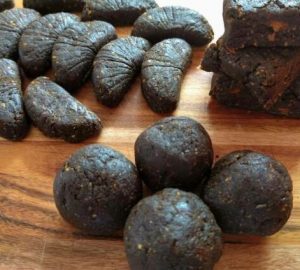
Quantifying the benefits of fat for open water swimmers
Anecdotal evidence suggests a carrying a little extra weight helps protect a swimmer against the cold. Additionally, a study that measured the core temperature of swimmers after a long-distance open water challenge found an inverse correlation between body mass index (BMI) and drop in core body temperature. BMI, which is defined as your mass divided by your height squared, is not necessarily measure of body fat as a heavily muscled person can have a high BMI but in many cases it is a reasonable proxy.
Size is important because a larger person has a lower surface area to volume ratio (as volume increases as the cube of length while surface area as the square). That’s why you tend to find larger penguins live further south than smaller ones; they can cope with the cold better.
Long-distance open water swimmers routinely try to increase weight before a major swim but we’ve not yet seen anything that attempts to quantify the benefits of piling on the pounds, so we’ve attempted an analysis of our own and would be interested to hear other people’s thoughts on this, especially from any biologists or physicists. While it’s fairly clear that larger people have an advantage when it comes to coping with cold water, the question we want to look at is, all other things being equal, what is the benefit to an individual swimmer in increasing their body weight.
From an experimental point of view this is very difficult to assess as when people are training for long-distance open water swims they are typically regularly exposing themselves to cold, and hence acclimatising psychologically as well as adding weight. The increased fitness from training may also compensate from any loss in performance caused by having to drag a larger body through the water. So when someone says, “I’ve put on weight and it definitely helps me stay in the water longer,” how do we know it’s the additional fat or whether their mind and body has adapted in some other way?
In brief, it’s complicated.
We therefore decided to attempt a mathematical analysis of what might be going on. We’ve necessarily made some broad assumptions, and our analysis may well be totally wide of the mark, so do let us know what you think.
Some sums
We suggest there are two mechanisms by which increasing weight can potentially boost tolerance to the cold: a larger body takes longer to cool down and fat may act to insulate the core.
Taking size first. Newton’s law of cooling says the rate of change in temperature is proportional to the difference in temperature between the object and the ambient temperature multiplied by the object’s surface and divided by its mass multiplied by its specific heat capacity. Specific heat capacity is a measure of the energy required to raise the temperature of a material. We can write that as follows:
- Rate of fall in temperature (R) = kA(Tb-Tw)/mc
Where k is a constant, A is surface area, Tb is the body temperature, Tw is water temperature, m is mass and c is specific heat capacity of the body.
Imagine a swimmer that increases his (or her) weight from m1 to m2. We can then write two equations as follows:
- R1 = kA1 (Tb-Tw)/m1c
And
- R2 = kA2 (Tb-Tw)/m2c
Where R1 is the rate the swimmer cools when he weighs m1 and R2 is the rate he cools when he weighs m2.
What we want to find is the additional time the swimmer can tolerate the cold by increasing weight, or the percentage decrease in the rate of heat loss:
- % change in rate of heat loss = (R2-R1)/R1
- = [kA2(Tb-Tw)/m2c – kA1(Tb-Tw)/m1c]/ (kA1(Tb-Tw)/m1c)
This looks a little complicated but bear with us because a lot of the terms cancel out leaving us:
- = [A2/m2 – A1/m1]/(A1/m1)= [(A2/m2)/(A1/m1)] – 1
Now, let’s say the swimmer has increased weight be a factor f, so m2 = m1 x f
If your weight increases, so does your volume, roughly in proportion to the increase in weight. But, surface area increases at a slower rate (remember the squares and cubes from above), so we can estimate the increase in surface area as follows:
- A2 = A1 x f^(2/3) (i.e. f raised to the power 2/3)
We can now substitute for A2 and m2 in our rate of heat loss equation above, so:
- % change in rate of heat loss = [((A1xf^(2/3))/(m1xf))/(A1/m)] – 1
Mass and area now cancel out so that
- % change in rate of heat loss = (1/f^(1/3))-1
In other words, the percentage change in your rate of heat loss by increasing your weight by a factor f is 1 divided by the cube root of f, minus 1.
Which means we can estimate that if you increase your body weight by 10% you change your rate of heat loss by (1/(1.1)^(1/3))-1 = -3.1%
So if your current tolerance for swimming at a particular temperature is 1 hour, increasing your body weight by 10% will allow you to stay in the water for an extra 1 minute and 53 seconds.
Remember, this is nothing to do with fat, just increase in body weight, which could perhaps more usefully come from additional muscle rather than fat.
Insulation benefits
The other purported benefit of fat is that it adds a layer of insulation. Let’s see if we can also quantify that.
Imagine a swimmer whose original weight is m and body fat percentage is b.
Simplify things by assuming all components of the body have the same density (they obviously don’t but for our purposes it doesn’t matter too much). We can then say:
- Weight of body fat = mb/100
- If the density of fat is d then the volume of fat in the body V = mb/100d
And if the fat is spread over an area A in the body then its average thickness t can be calculated as follows:
- t = mb/(100Ad)
We want to find the increase in the thickness of the layer of fat if we increase weight by a factor f.
- t1 = m1b/(100A1d) and t2 = m2b/(100A2d) and m2 = m1 x f and A2 = A1 x f^(2/3)
- Thus (t2-t1)/t1 = [m1fb/100dA1f^(2/3) – m1b/100A1d] / (m1b/100A1d)
Most terms cancel leaving % increase in fat thickness = 100 x ((f^(1/3)) – 1)
Making the assumption that the key route of heat loss through the body is via conduction, and that the rate is inversely proportional to the thickness of body fat we can therefore say the rate of heat loss decreases by 3.1% if you increase body fat by 10%.
Thus a swimmer who increases their body weight by 10% by adding fat can increase the time they stay in the water by 6.2% or about 4 minutes for every hour they could sustain at their previous weight. This of course also assumes that your ability to generate heat doesn’t change as you increase body weight. It also says nothing about the mental adaptations, that many swimmers say are key in beating the cold.
Is it worth it?
Back in issue 1 of the magazine (that you can read for free here) we looked at the question of how body fat affects your swimming speed. The studies are few and far between, and the only one we could find with numerical data comes from the Journal of Strength and Conditioning Research back in 1994 that used latex pads to simulate body fat and measured sprinting speed in competitive swimmers.
Body fat affects swimming speed in a number of ways. Because fat is less dense than other body constituents, increasing body fat tends to make you more buoyant, which can lift you higher in the water, reduce drag and perhaps make you faster. On the other hand, the additional fat increases the size of the body you have to pull through the water, and increases your surface area, causing to more drag.
The study indicated that a 2% increase in body fat slowed the swimmers by 3%, implying that a 10% increase in body fat could slow a swimmer by a massive 15% – meaning that what previously took you an hour to swim could now take an hour and 9 minutes.
Of course, there are lots of caveats here. Firstly, latex pads are not the same as body fat and therefore will not affect the body in exactly the same way. Secondly, these studies were on sprinters racing over 50 yards. Drag increases in proportion to velocity squared – i.e. if you double your speed, the drag increases 4 times. Equally, if you halve your speed the drag drops by 4 times. This is important here because long distance swimmers will probably be moving at half the speed of sprinters so the hydrodynamic drag component of the additional fat will be significantly less. It could perhaps reduce the above mentioned 15% to something like 4%. However, the faster swimmer you are originally, the greater the impact additional fat. Some swimmers even report that they swim faster as they gain weight, but this could be a result of the additional training they’re putting in, rather than the weight.
The conclusion therefore seems to be that yes, increasing body fat can help you tolerate cold water for longer but piling on the pounds could slow your swim by a similar amount. So, is it worth it? Conventional wisdom, common practice and hundreds of swimmers say yes. The numbers indicate possibly not. We also know that some skinny people do successfully complete cold water swims.
We don’t pretend we have the final answer and we’d love to know what people make of this analysis.








